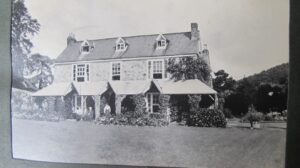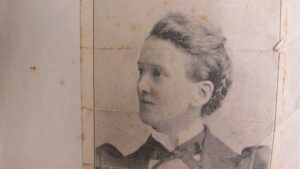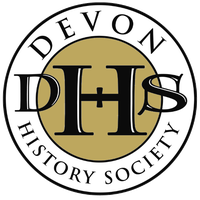Veley, Mrs Lilian, Knowle House, Lustleigh
Lilian Jane Veley (1861-1936) was born Lilian Gould in 1861 in Rectory House, Stokeinteignhead, Devon, the daughter of a Church of England vicar Rev. John Nutcombe Gould and his wife Katherine Grant.[1] She was the last born of their six daughters and six sons.[2]
Before Lilian’s tenth birthday the family moved to Knowle House, Lustleigh, which at that time was in the parish of Bovey Tracey and is now a Grade II listed building (Fig.1).[3]

Figure 1. Knowle House. Gould family archive, with their kind permission
Lilian was educated at home and the family, who have continued to live in the area, recall that there was a German governess.[4]
The first reference we have of Lilian as an adult is in the parish magazine of 1888 where she campaigned for owls to be protected. In 1890 she was secretary of, and assisted with, the local cookery classes which had an interesting aim, ‘We believe the connection between a happy home and knowledge of Cookery is nearer than we think. If a man comes home wet and weary and finds an untidy home with nothing clean or fit to eat he is apt to spend too much time and money in public houses’.[5]
By 1890 Lilian was attending the Newton Abbot District University Extension Association where she received an extra-mural prize from the University of Oxford for gaining distinction in a science course, ‘on the colour of insects.’ Lilian also gained a scholarship to attend Somerville Hall Oxford.[6] The other scholarship winners had their schools listed but Lilian had not attended school.
She was an outstanding student and graduated from Oxford with first class honours in natural sciences in 1894 (Fig.2). This was a very important achievement as women had only been admitted to the university from 1870 and still could not be awarded a degree.[7] Lilian was the only female Bovey Tracey university graduate so far found from the Victorian era.

Figure 2. Lilian Jane Gould 1894. Gould family archive with their kind permission
Lilian went on to published her research on bacteria in a national journal.[8] This was a source of pride for the local extension college where she had studied.[9]
In June 1895 the banns of marriage between Lilian Gould and Victor Veley (later to become a professor) were called at both the Bovey Tracey parish church and the church of St Philip and St James at Oxford where Victor resided.[10] Soon afterwards they married at the church of St John the Baptist in Lustleigh. Victor was a lecturer at Queen’s College Oxford and after their marriage they lived at 20 Bradmore Road St Giles, Oxford.[11]
Lilian’s next academic paper which was on her discovery of a bacterium in rum was published in 1897. This was a significant contribution to the sugar and rum trade where the faulty shipments of rum from Demerara were described as being a great loss to that colony and British Guiana. Her papers were published in Nature and also in the Journal of the Society of Industrial Chemistry.[12] In 1900 her further work on an organism in rum was published in Nature.[13] Her contribution as an early female scientist was acclaimed by a study in 1998.[14]
As soon as the Linnean Society opened its membership to women in 1904 Lilian was one of the first fifteen women to be elected as a fellow.[15] She published in its journal in 1905.[16] That same year she obtained a Doctor of Science degree from the University of Dublin.[17]
Lilian’s contributed to local science societies by taking positions of office and giving public lectures. She was secretary of the Oxfordshire Natural History Society which met at the Ashmolean Museum.[18] In 1900 she campaigned against the use of birds’ feathers in hats.[19] In 1908 she became a member of the advisory board of the Lyceum Club’s newly formed photographers’ section.[20]
It is from 1910 that we hear of Lilian’s involvement in the women’s franchise movement. By this time she had moved to 8 Marlborough Place Marylebone, London.[21] Lilian arranged and addressed meetings of the Conservative and Unionist Women’s Franchise Association speaking on women’s suffrage, and by 1912 she was chairman of its Marylebone and Paddington branch.[22] By 1914 she was a member of its council.[23] During World War 1 in 1915 she was involved with the Red Cross work of the Conservative League for Women’s Suffrage and spoke about this in the prestigious setting of the Great Hall, Church House, Westminster.[24] By this time Lilian was recorded as a member on active medical and soon became a Commandant in the British Red Cross.[25]
The Representation of the People Act 1918, which gave some women the vote, was a significant step assisted by their pioneering work in previous decades. At last Lilian’s own name appeared on the electoral register for 1919.[26] Bovey Tracey can be proud that its inhabitants included a woman who was one of the first to obtain a degree from Oxford, and went on to become one of the first female fellows of the Linnean Society and a prime mover in the women’s suffrage movement.
Entry created by Frances Billinge, June 2018
I would like to thank Lilian’s descendants for giving me access to their family archive and allowing me to use their photographs. Thanks also to Lustleigh Community Archive.
[1] St Mary the Virgin Hayes Middlesex Parish Register Marriages 1841; St Andrew’s Stokeinteignhead Parish Register Baptisms 1861.
[2] Census 1861.
[3] Census 1871; Historic England List Entry Number 1097395.
[4] Censuses 1871-1911; 1939 Register www.findmypast.co.uk .
[5] Lustleigh Community Archive, Lustleigh Parish Magazine Nov 1888, owls; Jan and Feb 1890 .cookery classes
[6] East and South Devon Advertiser 28 Jun 1890, 8, prize; London Evening Standard, 24 May 1890 3, scholarship.
[7] London Evening Standard 16 June 1894, 5 , degree; Oxford University Archives, Bodleian Libraries, 2007. First woman graduates of the University, the first women to obtain honours in the university examinations was in 1877, and the first degree graduation was not until 1920 www.bodleian.ox.ac.uk accessed 2 April 2018.
[8] Leeds Times 10 June 1893, 6.
[9] East and South Devon Advertiser 6 October 1894, 5.
[10] Parish registers Marriages- Banns 1895 St Thomas Bovey Tracey and St Philip and St James Oxford; EPG, July 1895, 13.
[11] Census 1900, 1911; electoral register Victor Veley 1903 www.ancestry.co.uk; Kelly’s Directory of Berkshire, Bucks and Oxon 1903 (London, Kelly’s Directories Ltd.) 381; Kelly’s Diretory of Oxon 1907 (London, Kelly’s Directories Ltd.) 402.
[12] V. H. and L.J. Veley, ‘A Bacterium living in strong spirit’, Nature, 56, 197, 1897; V. and L. Veley, ‘Micro-Organisms of faulty rum’, Journal of the Society of Chemical Industry, 16, 1897, 626; The Globe 9 Jul 1897, 6. reported the loss to trade from Demerara.
[13] V. and L. Veley, The Micro-Organism of Faulty Rum, Nature, 61, 1899-1900, 468-9.
[14] Mary. R.S. Creesework, Ladies in the Laboratory? American and British Women in Science, 1800-1900 (Folkestone, Scarecrow Press, 1998).
[15] Morning Post 16 Dec 1904 7.
[16] Lilian J. Veley (née Gould) ‘A further Contribution to the Study of Pelomyxa palustris (Greeff)’. Linnean Society Journal of Zoology, 29, 1905, 337- 395, 374.
[17] Chelmsford Chronicle 14 Jul 1905, 4.
[18] Oxford Times 1 Feb 1896, 3.
[19] Ibid. 24 Nov 1900, 3.
[20] Paisley and Renfrewshire Gazette 31 Oct 1908, 2.
[21] 1910 and 1914 electoral roll for Victor Veley, www.ancestry.co.uk ; 1911 Census.
[22] The Conservative and Unionist Womens’ Franchise Review 1 Feb 1910, 12; ibid. 1 Jan 1912, 186.
[23] Church League for Women’s Suffrage 1 Oct 1913, 344.
[24] Votes for Women January 22 1915, 144.
[25] Church League for Women’s Suffrage 1 Feb. 1918. 14 members on active service; 1 Nov 1915, 187 Commandant British Red Cross.
[26] Electoral register 1919 www.ancestry.co.uk .
